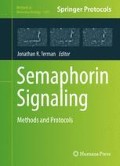Abstract
The axonal growth cone is a specialized structure enabling axon extension and proper guidance to its target by sensing the extracellular environment. A growth cone collapse assay is a popular approach designed to characterize the inhibitory effect of secreted guidance cues in vitro. However, the actin cytoskeleton of the growth cone is very sensitive to various factors like physical impact, temperature, and acidity of environment that may also induce responses resembling those of guidance signals. Herein, we provide an easy and reproducible method to analyze growth cone sensitivity to the prototypic guidance molecule family class 3 semaphorin. This protocol is intended to present a systematic approach that is easy to apply to any soluble factors with a potential to impact axon elongation.
L.A.T Meyer and A. Kaselis both authors have contributed equally.
Access this chapter
Tax calculation will be finalised at checkout
Purchases are for personal use only
References
Tessier-Lavigne M, Goodman CS (1996) The molecular biology of axon guidance. Science 274:1123–1133
Satkauskas S, Muller A, Roth M et al (2010) Molecular substrates for growing neurons in culture. In: Doering LC (ed) Protocols for neural cell culture. Humana Press, New York, pp 313–327
Polleux F, Ghosh A (2002) The slice overlay assay: a versatile tool to study the influence of extracellular signals on neuronal development. Sci STKE 136:pl9
Rivas RJ, Burmeister DW, Goldberg DJ (1992) Rapid effects of laminin on the growth cone. Neuron 8:107–115
Tang D, Goldberg DJ (2000) Bundling of microtubules in the growth cone induced by laminin. Mol Cell Neurosci 15:303–313
Roth L, Koncina E, Satkauskas S et al (2009) The many faces of semaphorins: from development to pathology. Cell Mol Life Sci 66:649–666
Piper M, van Horck F, Holt C (2007) The role of cyclic nucleotides in axon guidance. Adv Exp Med Biol 621:134–143
Petersen OH, Cancela JM (2000) Attraction or repulsion by local Ca(2+) signals. Curr Biol 10:311–314
Gomez TM, Zheng JQ (2006) The molecular basis for calcium-dependent axon pathfinding. Nat Rev Neurosci 7:115–125
Goodhill GJ, Baier H (1998) Axon guidance: stretching gradients to the limit. Neural Comput 10:521–527
Fujisawa H (2004) Discovery of semaphorin receptors, neuropilin and plexin, and their functions in neural development. J Neurobiol 59:24–33
Bagnard D, Lohrum M, Uziel D et al (1998) Semaphorins act as attractive and repulsive guidance signals during the development of cortical projections. Development 125:5043–5053
Adams RH, Lohrum M, Klostermann A et al (1997) The chemorepulsive activity of secreted semaphorins is regulated by furin-dependent proteolytic processing. EMBO J 16:6077–6086
Fan J, Mansfield SG, Redmond T et al (1993) The organization of F-actin and microtubules in growth cones exposed to a brain-derived collapsing factor. J Cell Biol 121:867–878
Behar O, Mizuno K, Badminton M et al (1999) Semaphorin 3A growth cone collapse requires a sequence homologous to tarantula hanatoxin. Proc Natl Acad Sci U S A 96:13501–13505
Bagnard D, Vaillant C, Khuth S-T et al (2001) Semaphorin 3A—vascular endothelial growth factor-165 balance mediates migration and apoptosis of neural progenitor cells by the recruitment of shared receptor. J Neurosci 21:3332–3341
Acknowledgment
This work has been published within the LABEX ANR-10-LABX-0034 Medalis and received a financial support from French Government managed by “Agence National de la Recherche” under “Programme d’investissement d’avenir” and Fondation pour la Recherche Médicale (FRM/Rotary International).
Author information
Authors and Affiliations
Corresponding author
Editor information
Editors and Affiliations
Rights and permissions
Copyright information
© 2017 Springer Science+Business Media New York
About this protocol
Cite this protocol
Meyer, L.A.T., Kaselis, A., Satkauskas, S., Bagnard, D. (2017). Analysis of Semaphorin-Induced Growth Cone Collapse and Axon Growth Inhibition. In: Terman, J. (eds) Semaphorin Signaling. Methods in Molecular Biology, vol 1493. Humana Press, New York, NY. https://doi.org/10.1007/978-1-4939-6448-2_12
Download citation
DOI: https://doi.org/10.1007/978-1-4939-6448-2_12
Published:
Publisher Name: Humana Press, New York, NY
Print ISBN: 978-1-4939-6446-8
Online ISBN: 978-1-4939-6448-2
eBook Packages: Springer Protocols

